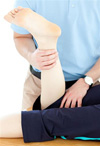What We Treat
Heel & Foot Pain / Plantar Fasciitis

Plantar Fasciitis (pronounced ‘plantar fash itis’) is inflammation of the thick, protective layer of tissue on the sole of the foot. It can cause pain in the heel, or forefoot but is not the only possible cause of pain in this area.
The Plantar Fascia runs along the bottom of the foot from the heel towards the toes. It provides some degree of protection when we stand, especially in bare feet.
Problems can arise as a result of poor foot or heel positioning, or from prolonged periods of weight bearing. It is especially common in runners.

The pain usually starts locally at the heel and then can spread along the sole of the foot. It is usually very noticeable with the first few steps of the day.
Symptoms can be reduced greatly using electrotherapy and manual therapy techniques.
The foot is a very complex part of our body. The 26 bones change in a split second from being a ‘loose bag’, allowing the foot to conform to uneven surfaces, into a rigid lever providing the platform to drive our body forwards when we walk or run. All this is controlled by the muscle acting on the foot and ankle some of which are located in the foot itself but any are situated in the calf.
One very common site of problems in the foot is the Big Toe (or Great Hallux). The joint at the base of the Hallux (the 1st Metatarsophalangeal joint) is prone to arthritis, especially in ladies with a preference for high heels!
The joint becomes stiff, sore and inflamed and the position of the toe starts to change, drifting toward the other toes. This is known as Hallux Valgus and a bunion forms on the inside edge at the base of the toe.

All of this can cause a good deal of problem with the way we walk (or our ‘gait).
Firstly, to walk normally we need 65° of extension in the joint at the base of the Big Toe.
Secondly pain around this joint will cause us to alter the way we bear our weight which can lead to other structures becoming strained around the foot, ankle, knee, hip or lower back.
And thirdly, as the position of the Hallux alters it can have a knock on effect into the other toes and forefoot as well, completely altering the way the foot functions.



